|
|
|
|
|
|
|
|

 MICHIGAN STATE UNIVERSITY
EXTENSION
MICHIGAN STATE UNIVERSITY
EXTENSION
BEECH BARK DISEASE ALERT
Revised November, 2000
| Michigan BBD contacts | ||
| Deb McCullough Michigan State University 152 Natural Science East Lansing, MI 48824-1115 1-517-355-7445 |
Bob Heyd DNR Forest Health Specialist 1990 U.S. 41 South Marquette, MI 49855 1-906-228-6561 |
Roger Mech DNR Forest Health Specialist 8717 North Roscommon Road Box 128 Roscommon, MI 48653 1-989-275-5151 |
Biology
and Management of Beech Bark Disease
Michigan’s Newest Exotic Forest Pest
By Deborah G. McCullough1, Robert Heyd2, and Joseph G. O'Brien3
1
Associate Professor, Dept. of Entomology and Dept. of Forestry, Michigan State UniversityPhotos courtesy of the U.S. Forest Service and Bill Cook.
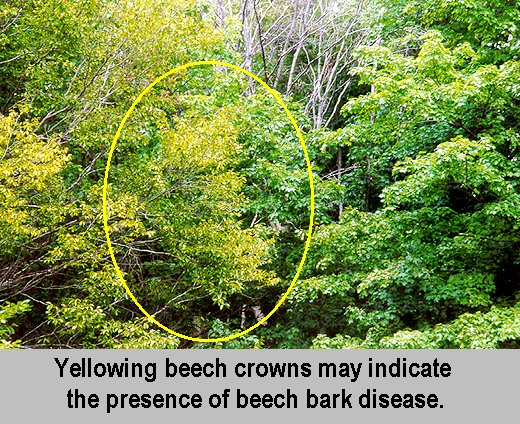 Beech bark disease is one of the latest exotic pest problems to
plague Michigan forests. Beech bark disease refers to a complex
that consists of a sap-feeding scale insect and at least two species of Nectria fungi. Beech bark disease begins
when American beech (Fagus grandifolia) becomes infested with beech scale (Cryptococcus
fagisuga Lind) (=Cryptococcus fagi Baer.). The tiny scale insects, found on the tree
trunk and branches, feed on sap in the inner bark. White wax covers the bodies of the
scales. When trees are heavily infested, they appear to be covered by white wool. Minute
wounds and injuries caused by the scale insects eventually enable the Nectria fungus to
enter the tree. Nectria kills areas of woody tissue, sometimes creating cankers on the
tree stem and large branches. If enough tissue is killed, the tree will be girdled and
die. Other trees may linger for several years, eventually succumbing to Nectria or other
pathogens. Some infected trees will break off in heavy winds – a condition called "beech snap". Dense thickets of root sprouts are common
after trees die or break.
Beech bark disease is one of the latest exotic pest problems to
plague Michigan forests. Beech bark disease refers to a complex
that consists of a sap-feeding scale insect and at least two species of Nectria fungi. Beech bark disease begins
when American beech (Fagus grandifolia) becomes infested with beech scale (Cryptococcus
fagisuga Lind) (=Cryptococcus fagi Baer.). The tiny scale insects, found on the tree
trunk and branches, feed on sap in the inner bark. White wax covers the bodies of the
scales. When trees are heavily infested, they appear to be covered by white wool. Minute
wounds and injuries caused by the scale insects eventually enable the Nectria fungus to
enter the tree. Nectria kills areas of woody tissue, sometimes creating cankers on the
tree stem and large branches. If enough tissue is killed, the tree will be girdled and
die. Other trees may linger for several years, eventually succumbing to Nectria or other
pathogens. Some infected trees will break off in heavy winds – a condition called "beech snap". Dense thickets of root sprouts are common
after trees die or break.
Managing beech bark disease in Michigan will be challenging. Both the scale insects and the fungal spores can be transported in the wind. Eventually beech scale and beech bark disease will affect beech trees throughout Michigan. The goal of this bulletin is to help you understand the biology and impacts of this new pest, and potential management options.
Distribution: Beech scale was accidentally introduced into Nova Scotia in 1890 on ornamental beech imported from Europe. By the early 1930’s, the scale and associated Nectria fungi were found throughout the Maritimes Provinces in eastern Canada and in localized areas of Maine. Much of New England and parts of New York were affected by 1960 and the disease had expanded into northeastern Pennsylvania by 1975. Beech bark disease has continued to spread through much of Quebec, northern Pennsylvania and most recently, northeastern West Virginia. Localized infestations of beech scale have also been found in Virginia, North Carolina, Tennessee, Ohio and Ontario.
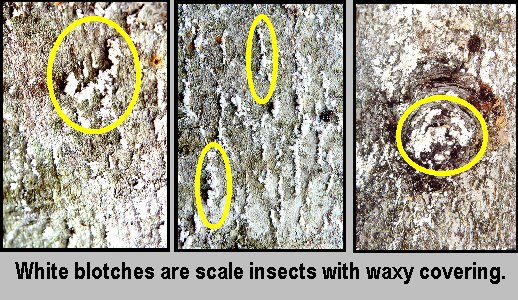
Beech scale and beech bark disease were first discovered in Michigan in 2000. To date, affected beech trees have been found in several counties in the northwestern Lower Peninsula and in areas of the eastern Upper Peninsula. As detection efforts continue, other infested areas will likely be found.
Beech scales are yellow, soft-bodied insects that are 0.5 to 1.0 mm long as adults. They feed only American and European (Fagus sylvatica) beech trees. Adult scales are legless, wingless and have only rudimentary antennae. Several glands secrete the white "wooly" wax that covers their body. Scales reproduce by parthenogenesis, which means that all beech scales are females and no mating occurs. This form of reproduction enables scale populations to build rapidly when suitable hosts are present.
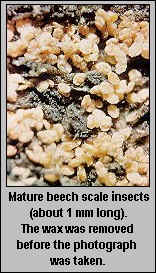 Life cycle: Beech scale has one generation per year. Adults lay
pale yellow eggs on the bark in midsummer, then die. Eggs are attached end-to-end in
strings of 4 to 7 eggs. Eggs hatch from late summer until early winter. The immature
scales that hatch from eggs are called crawlers or nymphs. Unlike adults, crawlers have
functional antennae and legs and can move about. When a crawler finds a suitable location
on a host tree, it forces its long, tube-like stylet into the bark and begins to suck sap
from the tree. Once a crawler begins to feed, it will molt to the second stage. Second
stage crawlers have no legs and are immobile. They produce the white wax that eventually
covers their bodies. Second stage crawlers overwinter and molt to the adult stage the
following spring.
Life cycle: Beech scale has one generation per year. Adults lay
pale yellow eggs on the bark in midsummer, then die. Eggs are attached end-to-end in
strings of 4 to 7 eggs. Eggs hatch from late summer until early winter. The immature
scales that hatch from eggs are called crawlers or nymphs. Unlike adults, crawlers have
functional antennae and legs and can move about. When a crawler finds a suitable location
on a host tree, it forces its long, tube-like stylet into the bark and begins to suck sap
from the tree. Once a crawler begins to feed, it will molt to the second stage. Second
stage crawlers have no legs and are immobile. They produce the white wax that eventually
covers their bodies. Second stage crawlers overwinter and molt to the adult stage the
following spring.
Mortality factors: Crawlers that fall from trees or are washed off during heavy rains in late summer and autumn usually die. Severely cold winter temperatures (e.g. –35oF) that persist for at least a few days may kill some overwintering crawlers, but others will be insulated by snow or protected by moss. A small, twice-stabbed ladybird beetle, Chilocorus stigma (Say), feeds on this scale and is common in Michigan. Although this predator will reduce scale numbers on some trees, it cannot control an infestation.
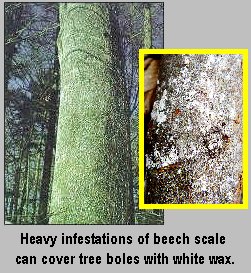
Spread: When eggs hatch, crawlers may remain under the body of the adult or move to other areas of the same tree. Some of the wingless crawlers are blown to other trees. A small number of crawlers may be carried for long distances in air streams above forest canopies. Birds probably transport crawlers short distances and perhaps long distances during migratory flights. In addition, the beech scale infestations in Michigan, West Virginia and Ohio all centered on campgrounds or scenic areas, suggesting that humans likely play a role in moving scales long distances. For example, transporting infested beech firewood between mid-summer and early winter could allow mobile, first stage crawlers to infest new areas.
Symptoms of scale infestation: Crawlers prefer to colonize areas of the tree where the bark is rough. Newly infested trees usually have the first small spots or patches of "white wool" on the trunk around areas of rough bark. Infestations often start near old branch stubs, under large branches, or sometimes beneath mosses or certain lichens. As the scale population builds, the entire trunk and large branches of the tree may be covered with white wool.
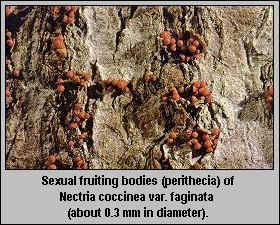 Three species of Nectria
fungi are associated with beech bark disease in North America. Nectria galligena
is a native pathogen that causes perennial cankers on many hardwood species. It rarely
affects beech, however, unless beech scale is present. Another species, Nectria
coccinea var. faginata, is an exotic pathogen that was introduced from Europe. Often,
the native Nectria species is the first to invade trees infested by beech scale, followed
by the exotic Nectria species. A third Nectria species, N. ochroleuca, has been
found in association with beech bark disease in Pennsylvania, West Virginia and Ontario,
Canada. The asexual form of N. ochroleuca (Gliocladium roseum) has also been
found on beech trees in Michigan.
Three species of Nectria
fungi are associated with beech bark disease in North America. Nectria galligena
is a native pathogen that causes perennial cankers on many hardwood species. It rarely
affects beech, however, unless beech scale is present. Another species, Nectria
coccinea var. faginata, is an exotic pathogen that was introduced from Europe. Often,
the native Nectria species is the first to invade trees infested by beech scale, followed
by the exotic Nectria species. A third Nectria species, N. ochroleuca, has been
found in association with beech bark disease in Pennsylvania, West Virginia and Ontario,
Canada. The asexual form of N. ochroleuca (Gliocladium roseum) has also been
found on beech trees in Michigan.
Both the native and exotic fungi produce fruiting bodies called perithecia. Perithecia of N. galligena and N. coccinea var. faginatatea tiny, bright red, and occur in clusters on living or dead bark. Perithecia of N. ochroleuca are lighter in color – usually salmon or pink. Each perithecium is filled with sacs of spores. These spores are the sexual stage of the fungi. Spores are released from perithecia in the fall and can be carried in the wind. On some infected trees, perithecia are abundant, causing large areas of the bark to appear red. In Michigan and some other areas, however, perithecia can be difficult to find.
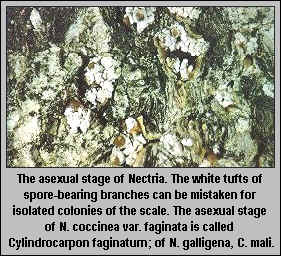 All
three Nectria species can also form spores by an asexual process. Small, white or pink
cushions of these asexual spores sometimes burst through the bark before perithecia
appear. The asexual spores can be found from mid-summer through fall and can be mistaken
for small colonies of the beech scale. These spores are also wind disseminated.
All
three Nectria species can also form spores by an asexual process. Small, white or pink
cushions of these asexual spores sometimes burst through the bark before perithecia
appear. The asexual spores can be found from mid-summer through fall and can be mistaken
for small colonies of the beech scale. These spores are also wind disseminated.
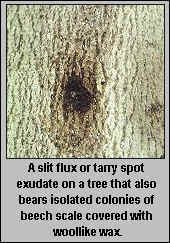 Symptoms of Nectria infection: Tarry spots are often an early
symptom of trees infected by Nectria. Tarry spots occur when a brownish fluid oozes from a
dead spot on the trunk. Perithecia sometimes form around the tarry spots. Other injuries,
however, can also cause tarry spots to form.
Symptoms of Nectria infection: Tarry spots are often an early
symptom of trees infected by Nectria. Tarry spots occur when a brownish fluid oozes from a
dead spot on the trunk. Perithecia sometimes form around the tarry spots. Other injuries,
however, can also cause tarry spots to form.
Typically only the bark and inner bark are killed by the Nectria fungi, but occasionally dead areas may extend into the sapwood when the cankers are infected by other fungi. The Nectria fungi may infect localized areas on the tree, causing linear strips of bark to die along the tree trunk or branches. If larger or more numerous areas are infected, the tree may be girdled and killed. If the fungus invades only narrow strips of bark on vigorous trees, callus tissue often forms and the bark becomes rough. Sometimes the tree is able to wall off these cankers if they are small. If beech scale numbers are high, however, Nectria often spreads or coalesces rapidly and is not likely to be restricted by callus formation. Scales cannot survive on tissue that has been killed by the fungus. A strip of scale-free bark running down an otherwise infested tree often indicates where bark has died.
Trees dying from Nectria infection usually have a distinct appearance when viewed from a distance. Leaves that emerge in spring do not mature, causing crowns to appear thin or raggedy. Leaves remain on the trees but become yellowish later in the summer.
STAGES OF BEECH BARK DISEASE INVASION
Beech bark disease develops in three stages identified as the Advancing Front, the Killing Front and the Aftermath Forest.
The Advancing Front refers to stands where trees are infested with beech scale but not yet infected by Nectria. Estimates from northeastern forests suggest that beech scale and the Advancing Front spread at roughly 6 miles per year. Stands can be infested with beech scale for several years before Nectria infection is widespread, particularly when the infestation is a long distance from other affected areas.
The Killing Front refers to stands where beech scale populations are high and Nectria infection is abundant. Tree mortality is heavy within the killing front.
The Aftermath Forest refers to stands that have experienced the first wave of beech mortality. These stands typically have lower populations of beech scale than previous stages. Residual beech trees in the Aftermath Forest are mostly defective and declining.. Some large trees remain – many of these large trees simply escaped scale infestation or Nectria infection, but some are at least partially resistant.
IMPACT OF BEECH BARK DISEASE
Tree Mortality – Although high populations of beech scale can weaken a tree, beech bark disease and mortality do not occur until Nectria invades infested trees. This usually happens 3 to 6 years after scales initially infest an area. It can take longer, however, if the area is a long distance from other beeches infected with Nectria, or if the amount of Nectria inoculum in the area is low. Once Nectria invasion begins, the largest trees and trees with heavy scale infestations (usually rough-barked trees) are most likely to be killed.
The first wave of beech bark disease in northern Pennsylvania forests killed roughly 50% of the beech trees larger than 10 inches in diameter at breast height (dbh). Another 25% of the trees lived, but were infected by Nectria. These trees were weak, grew slowly and had patches of dead tissue. The remaining 25% of the trees either escaped scale infestation or Nectria infection, or are at least somewhat resistant. In Maine forests where beech bark disease has been present for more than 60 years, most large-diameter beech trees have been killed. Trees that escaped heavy scale infestation often remained alive but were highly defective.
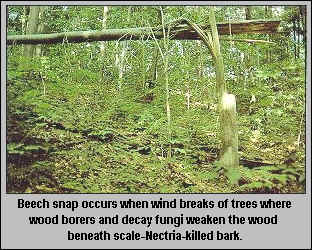 Other
insects and fungal pathogens can invade wood killed by beech bark disease. These organisms
can increase the severity of defects initiated by beech bark disease. Ambrosia beetles
often bore into dead sapwood and their galleries weaken areas of the tree. Many trees that
are partially girdled by Nectria and/or those with ambrosia beetle galleries are broken by
high winds. This breakage is called "beech snap".
Live trees with areas of dead tissue are also invaded by other fungi, including Hypoxylon
and Armillaria.
Other
insects and fungal pathogens can invade wood killed by beech bark disease. These organisms
can increase the severity of defects initiated by beech bark disease. Ambrosia beetles
often bore into dead sapwood and their galleries weaken areas of the tree. Many trees that
are partially girdled by Nectria and/or those with ambrosia beetle galleries are broken by
high winds. This breakage is called "beech snap".
Live trees with areas of dead tissue are also invaded by other fungi, including Hypoxylon
and Armillaria.
Young beech trees that escape or regenerate after the first wave of mortality can be colonized by a second scale insect (Xylococculus betulae [Perg.] Morrison). This scale can cause rough areas to form on the stem that are attractive to the beech scale, which then leads to Nectria infection.
Older trees that have decayed or broken crowns before beech bark disease invades a stand are often the first to succumb to beech bark disease. Severe drought or consecutive years of severe defoliation have also been associated with massive invasion by Nectria.
Wildlife – Beech provides food and habitat for more than 40 species of birds and mammals. Many animals feed on beech nuts in the fall and winter, including black bears, gray squirrels, chipmunks, turkeys and deer. Trees begin to produce substantial numbers of nuts at about age 40. By age 60, large nut crops are produced every 2 to 8 years. This hard mast is especially important in northern forests where oak and hickory are rare. Branching characteristics of beech trees make them attractive to raptors for perches and several species of hawks prefer to nest in beech trees. Standing beech trees that have some decay are used for nesting, roosting or insect foraging by a variety of birds, ranging from pileated woodpeckers to nuthatches. Pine martens, fishers and other mammals use cavities in beech trees for shelter or dens.
Effects of beech bark disease on wildlife will depend on the density and size of beech trees in a stand, and the availability of alternative hard mast producers such as oak, hickory or hazel. Large, open-grown wolf trees and trees with decay are often most valuable to wildlife, but will be highly vulnerable to beech bark disease. Trees that die from beech bark disease will provide habitat for some wildlife species for a number of years, either as standing dead trees or as coarse woody debris. Over the long-term, however, the number of large beech trees will decrease.
Regeneration and beech thickets – In Maine, foresters found that one long-term result of beech bark disease was a shift in species composition – toward an increased number of beech stems. This resulted from heavy root sprouting after beech trees were cut (for presalvage or salvage) or killed by beech bark disease. In the northeast, foresters refer to this dense regeneration as "beech thickets". Beech thickets are often impenetrable, exclude regeneration of other species, and have little value for wildlife. Sprouts that develop from parent trees that were killed by beech bark disease will also be susceptible to the disease. If root sprouts from susceptible trees are allowed to grow, the long-term susceptibility of stands to beech bark disease will increase.
Wood defects – Research in New York stands that were affected by beech bark disease for at least 10 years showed that most external defects associated with the disease were superficial. Trees with raised lesions or blocky bark (indicating that Nectria was walled off) had little or no wood defect. Most defects were removed with the bark slab at the sawmill. Sunken lesions could cause defects over time, usually because of bark inclusions buried in wood. Defects associated with sunken bark lesions generally affected lumber grade rather than volume. Trees that were heavily infested by scale and had large patches of dead bark had extensive wood defects or, more typically, died.
RESISTANCE TO BEECH BARK DISEASE
Studies in northeastern states have shown that some American beech trees are resistant to beech bark disease. In stands where beech scale infestation is generally heavy, insect-free trees are occasionally observed. Even in stands that have been affected by beech bark disease for years, trees that are free of insects and disease can be found. Trials have shown that roughly 1% of American beech is truly resistant to beech scale and beech bark disease. Other trees are partially resistant and are colonized by only a few scales. Resistance probably involves bark structure and chemistry that make certain trees unsuitable as hosts for the beech scale.
In eastern states where beech usually develops from root sprouts, resistant trees tend to occur in groups and are genetically related. However, beech may regenerate from seeds more often in Michigan and other areas in the western portion of its range than in eastern areas. This could mean that resistance might exist at a slightly higher rate than in eastern states. This also suggests that resistant trees are as likely to be scattered through a stand as to occur in clumps. Obviously more experience with beech bark disease in Michigan will be needed to confirm these patterns. Efforts to identify and select resistant and partially resistant trees will be a critical part of reducing the long-term vulnerability of beech to beech bark disease.
MANAGING BEECH BARK DISEASE
Factors that affect development of beech bark disease include species composition and density of stands, and the size, age and vigor of trees within a stand. Selecting a proper management strategy depends on the disease status of the stand, as well as your management objectives. Management guidelines are presented here for stands that are (A) not yet infested by beech scale; (B) within the Advancing Front; (C) within the Killing Front and (D) in the Aftermath Forest. If your stand is within roughly 6 miles of a stand that is affected by beech scale or beech bark disease, treat the stand as if it were part of the Advancing Front.
Stands Free of Beech Scale
If your stand is beyond the advancing front, consider the potential vulnerability of the stand when you develop plans for thinning, harvesting or other silvicultural activities. Stands that are dominated by beech (e.g. 50% or more basal area) will be highly vulnerable to damage, especially if large or decayed trees are abundant. On the other hand, if beech is a minor component of the overstory, effects on the stand will be less severe. Management guidelines are presented separately for these situations.
If Beech is a minor component of the overstory: Generally, it will not be necessary to enter these stands specifically for beech bark disease control, but managers should consider the potential impacts of beech bark disease when setting up scheduled thinning or harvest operations. In this situation, mortality of beech trees may simply function like a selective thinning. Growth of other species will typically increase in response to increased availability of light, water or nutrients, especially in well-stocked stands (e.g. basal area of at least 90 ft2/ac). Beech thickets are not likely to be a severe problem in well-stocked stands where most root sprouts will be outcompeted by other species. Mortality of scattered large beech trees may increase the habitat available for birds, mammals and other wildlife.
If Beech is a major component of the overstory: If beech comprises more than 40 to 50% of the basal area in a stand, effects of beech bark disease may be severe. Preventative management can reduce the susceptibility of the stand to the eventual beech scale invasion and reduce the vulnerability of the stand to beech bark disease. Appropriate actions will depend upon the existing condition of the stand, the management objectives for the stand, and the proximity of the stand to the advancing front.
Consider reducing the amount of overstory beech present in the stand. It is not necessary or desireable to eliminate beech from a stand. However, increasing tree species diversity provides more management options and may reduce rates of beech scale reproduction and spread. Beech is relatively shade tolerant and often is outcompeted by other species in large canopy gaps where the ground is exposed to sunlight during much of the day. Birch, black cherry, red maple or other shade intolerant species will grow faster and overtop beech reproduction. Beech is avoided by browsing deer, however, which may decrease successful regeneration of more favored species in areas with high deer numbers. Leaving large snag or den trees to enhance wildlife habitat does not significantly increase the risk of tree loss from beech bark disease.
Retain vigorous trees with smooth bark. Identification of potentially resistant trees is important for decreasing the long-term susceptibility and vulnerability of forests to beech bark disease. Vigorous trees and trees with smooth bark will have fewer sites suitable for beech scale establishment and may be more resistant to Nectria invasion. In contrast, large, overmature trees, trees with rough bark, and trees with wounds, broken tops or other obvious problems are most likely to be infested by beech scale and most vulnerable to Nectria infection.
Use harvest systems that minimize injuries to beech root systems. Root injury can cause extensive root sprouting, especially if roots are injured in spring.
Consider use of herbicides to control beech regeneration. Herbicides may be needed to control beech regeneration, especially following selection or shelterwood harvests. Gylphosate (Roundup, Accord), tryclopyr (Garlon) or 2,4-D + tryclopyr (Crossbow) have been used effectively to control beech sprouts or advanced regeneration.
Survey stands regularly to detect the arrival of beech scale. Scale infestations usually begin on the trunk of large trees, often around branch stubs or other rough areas.
Favor regeneration of other tree species via selection or planting.
The Advancing Front
Survey stands that are infested with beech scale or considered to be within the
advancing front to
(1) determine the extent of the beech scale infestation;
(2) identify potentially resistant trees and
(3) prioritize trees for salvage.
Enter stands that are infested with beech scale first.
Identify, mark and retain resistant trees. In stands that are infested with beech scale, look for trees that have no beech scale or low numbers of scale, especially when these trees are growing near heavily infested trees. These trees may be resistant or at least partially resistant to beech scale. Often, resistant trees have smooth bark, but this may not always be the case. Resistant trees may occur in clumps or groups if they originated as root sprouts. However, resistant trees that regenerated from seed may be scattered through the stand. In eastern Canada, 5 to 6 trees per acre were resistant to beech scale. Identification and retention of potentially resistant trees is an important step for conserving the beech resource over the long-term.
Identify trees for salvage. Discriminate against trees that are heavily infested with beech scale. Large, overmature trees with rough bark, trees with evidence of decay, broken tops or other injuries are likely to succumb to beech bark disease. Retaining some of these trees for wildlife habitat will not affect spread or impact of beech bark disease. Generally, increasing species diversity and shifting the beech component towards smaller, more resistant size classes will reduce the impact of beech bark disease.
Beech regeneration may require control with herbicides, as noted above. If left uncontrolled, root sprouting is likely to result in dense beech thickets that are aesthetically unpleasing, have little wildlife value and inhibit regeneration of other species. Dense regeneration from root sprouts will also increase susceptibility of the stand to beech bark disease over the long-term.
Maintaining some beech in the overstory is often desirable, especially where wildlife habitat is an important management objective. Beech is frequently the primary nut producer in northern hardwood stands, and this hard mast provides an important food source for many animals. In stands where oak, hickory or hazel are abundant, beech mast may be less important.
Favor regeneration of other tree species via selection or planting.
Do not transport beech firewood or logs from infested stands to uninfested areas between mid-summer and late fall. First stage crawlers are mobile and might move from infested wood to live beech trees. This could establish beech scale infestations in new areas.
The Killing Front
Tree mortality usually starts soon after Nectria invasion begins. You may find tar spots, clusters of tiny, red perithecia and patches of dead bark on infected trees. Beech scale may actually be less abundant on these trees, because the scale insects will not survive on areas of wood that have been killed by Nectria.
Identify, mark and retain resistant trees as described above.
Salvage dead or declining trees with thin crowns and yellowish foliage. These trees are often invaded by secondary decay fungi that can degrade wood within 2 to 3 years. Remove trees with sunken lesions or large patches of dead wood – these trees are likely to have defects. Consider retaining some large trees to provide wildlife habitat.
Prioritize harvest of trees that are heavily infested by beech scale and/or infected by Nectria.
Consider control of beech regeneration with herbicides as described above.
Do not transport beech firewood or logs from infested stands to uninfested areas between mid-summer and late fall to prevent beech scale infestations from becoming established in new areas.
The Aftermath Forest
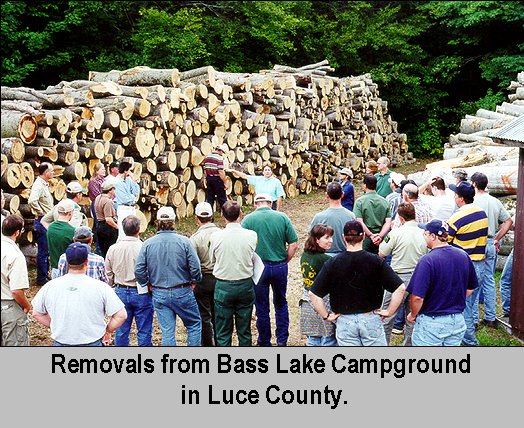
Aftermath forests are characterized by dense stands of infested beech sprouts and seedlings, and a scattering of larger, residual trees in varying condition. Clumps of resistant or partially resistant trees may be present. Beech saplings grow quickly when overstory trees are killed and may be able to compartmentalize cankers. These trees, however, often have sunken lesions, patches of dead bark and deformities that lead to defects. Trees with convoluted bark are seldom killed outright by Nectria, but grow slowly and remain weak. These trees will have low value and volume.
Salvage dead and dying trees. Small, defective or diseased trees can often be sold for fuelwood or chips.
Retain trees that are free of scales and Nectria and trees with few scales, especially if the trees have smooth bark. Resistant trees will be very obvious in the aftermath forest.
BEECH TREES IN RECREATION OR URBAN AREAS
Beech snap is common when trees have patches of dead bark resulting from Nectria infection. These dead patches are often invaded by other decay fungi or ambrosia beetles, further predisposing the tree to breakage. This creates a hazard to people and personal property when large beech trees occur in campgrounds or other recreation areas, or near homes.
Trees posing a hazard to people or property should be removed. In areas where beech is a dominant species, planting or encouraging the regeneration of other tree species before beech scale reaches your area increases reforestation options, and can soften the impact of the eventual loss of most large beech in the area.
When high value ornamental or yard trees are of concern, some protection from beech bark disease is possible by controlling the beech scale. Note that this is not a one-time treatment. This exotic insect is now a permanent resident of our forests. Continued protection is necessary to prevent scales from re-infesting trees and creating the wounds that allow invasion of the Nectria fungi.
Physical control: Scale insects can be removed by scrubbing a tree with a soft brush, using water from a high pressure nozzle on a garden hose or similar means. It is difficult, however, to remove scales from the upper part of the trunk or crown of large trees.
Oils: Dormant and horticultural oils are petroleum-based products that cover and suffocate soft-bodied insects such as aphids, spider mites and scales. Oils may be useful in controlling scales but they should be applied only when trees are dormant.
Insecticides: Registered insecticides can be used to control scales. Efforts are underway to identify effective products and optimal timing.
Burns, B.S. and D.R. Houston. 1987. Managing beech bark disease: evaluating defects and reducing losses. Northern Journal of Applied Forestry 4:28-33.
Houston, D.R. 1975. Beech bark disease: the aftermath forests are structured for a new outbreak. Journal of Forestry 73:660-663
Houston, D.R. 1994. Major new tree disease epidemics: beech bark disease. Annual Review of Phytopathology 32:75-87.
Houston, D.R. and J.T. O’Brien. 1983. Beech bark disease. USDA Forest Service, Forest Insect & Disease Leaflet No. 75. Northeastern Forest Experiment Station. 8 p.
Houston, D.R. and H.T. Valentine. 1988. Beech bark disease: the temporal pattern of cankering in aftermath forests of Maine. Canadian Journal of Forest Research 18:38-42.
Kielb, M. 1994. Cooper’s hawk, red-shouldered hawk, broad-winged hawk. pp. 63, 65, 67, In: The Birds of Michigan. G.A. McPeek and R.J. Adams, (eds.). Indiana University Press. Bloomington, IN.
Mackenzie, M. 1998. Beech bark disease silvicultural plots: a preliminary review of the overstory plots in C-52 Std-40, Allegheny National Forest. USDA Forest Service, Region 9, Morgantown, West Virginia, Internal report.
Mielke, M.E., D.R. Houston and A.T Bullard. Beech bark disease management alternatives. 1987. USDA Forest Service. pp. 272-280, In: Proceedings, Integrated Pest Management Symposium for Northern Forests, March 24-27, 1986. Cooperative Extension Service, University of Wisconsin-Extension. Madison, WI.
Mize, C.W. and R.V. Lea. 1978. The effect of beech bark disease on the growth and survival of beech in northern hardwoods. European Journal of Forest Pathology 9:243-248.
Ostrofsky, W.D. and M.L McCormack, Jr. 1986. Silvicultural management of beech and the beech bark disease. Northern Journal of Applied Forestry 3:89-91.
Powell, S.M., E.C. York, J.J. Scanlong and T.K. Fuller. 1997. Fisher maternal den sites in central New England. pp. 265-267, In: Martens: Taxonomy, Ecology, Techniques and Management. G. Prouis, H.N. Bryant and P.M. Woodward, (eds.). Provincial Museum of Alberta. Edmonton, Alberta.
Tubbs, C.H. and D.R. Houston. 1990. American beech. pp. 325-332, In: Silvics of North America, vol. 2: hardwoods. USDA For. Serv. Agric. Handbook 654.
Tubbs, C.H., R. Degraaf and W. Healy. 1987. Guide to wildlife tree management in New England northern hardwoods. USDA Forest Service, Northeastern Forest Experiment Station.

This website is maintained by Bill Cook, Michigan State University Extension
Forest in the Upper Peninsula. Comments, questions, and suggestions are gratefully accepted. Editorial issues can
be addressed to Eric Thompson.
Last update of this page was 08 July 2003.
This site is hosted by School of Forest Resources and Environmental Science at Michigan Technological University.